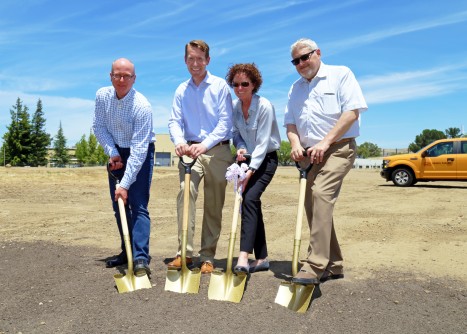Leadership from Lawrence Livermore National Laboratory (LLNL), the National Nuclear Security Administration (NNSA), Livermore Field Office (LFO) and contractor Hensel Phelps broke ground June 5 on the Applied Materials and Engineering (AME) campus at LLNL. The ground breaking was for the start of new building construction in the 2200 block of the Laboratory and will come online just in time to support a pair of major stockpile stewardship programs.
Addressing the crowd were Bill Goldstein, LLNL director; Kenneth Sheely, deputy associate administrator for Infrastructure in the NNSA Office of Safety, Infrastructure and Operations; and Janis Parenti, deputy manager of the Livermore Field Office. Scott Bills, operations manager for Hensel Phelps, joined the trio with shovels to break ground.
“I’m thankful to leadership by the Livermore Field Office and NA-50 to get this done,” said Goldstein. “We’re adding capabilities needed to support stockpile stewardship, and the warhead modernization programs in particular. There was real urgency, and everyone really stepped up to get this done.”
The “area plan,” sponsored both by LLNL and NNSA, aims to consolidate capabilities while reducing footprint and gaining efficiencies by collocating synergistic capabilities. The new buildings will house offices, polymers, joining and vapor deposition engineering capabilities.
“The buildings you’ll see will represent the success of a partnership that we plan to continue,” said Parenti.
The challenge involved relocating and revitalizing these capabilities into reliable, modern facilities in time to meet the needs of the warhead modernization programs currently underway. To meet this challenge, the LLNL Weapons Infrastructure Program, Engineering Directorate and NNSA conceived of a new area plan approach to redevelopment for the AME campus that focused on prioritizing the highest risk capabilities.
“This is a first for the NNSA community,” said Sheely, referring to the new approach. “The team here showed tremendous leadership in rethinking how we recapitalize infrastructure. This approach will reshape the entire enterprise.”
The hallmark of the area-plan approach is construction and renovation with the comprehensive approach of consolidating and collocating capabilities, new construction and facility repurposing. The area plan approach also integrates planning around facilities, equipment, and people to deliver a complete capability. Finally, it departs from the traditional like-for-like replacement by identifying areas where legacy equipment can be phased out without depleting the overall technical capability delivered. With this approach, the program can take beneficial occupancy and start making use of the capability as soon as possible. In the case of the AME campus, staff will begin moving into the first building in May 2020.
“This is all about delivering Laboratory science and technology capability in time for the warhead modernization programs,” said Katy Lu, Weapons Infrastructure deputy program leader. “Making this project happen is a testament to the partnership to find solutions and deliver mission-critical capability.”
